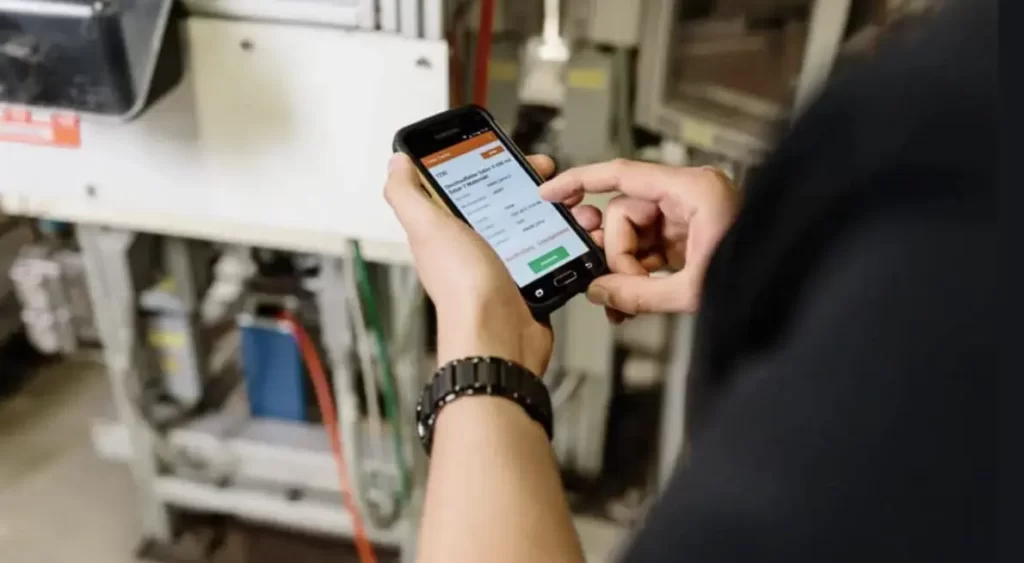Mobility Makes Factories Smarter – Is Yours?
Nearly 81% of Industrial Manufacturing CEOs said that they plan to rely on operational efficiencies to bolster growth via enhanced competitiveness. As of 2020, only 24 percent of manufacturers have implemented digital transformation programs beyond pilot stages. The ability to harness more sophisticated technologies begins with mobility. To maintain a competitive edge, manufacturers need to concentrate on the customer.

Following are nine key areas in the product life cycle where manufacturing companies can lean on mobile to make their factory smarter and operations more customer-centric. POPProbe provides these and more solutions to help in your mobile operations transformation. Even better, POPProbe is quick, easy, and affordable for most every business!
1. Employee Productivity
A Frost & Sullivan study shows that using mobile devices can increase employee productivity by an impressive 34 percent per day. Production workers can punch in and out using a mobile tablet, request time off and perform other administrative functions more conveniently.
2. Significant Decreases in Worker Training Time
Mobile devices can lead to better productivity of warehouse workers as people respond well to tech they already use and can perform tasks on the go. With today’s workforce already embracing mobility in their personal life, the traditional learning curve needed when introducing innovative technology, systems or processes is greatly reduced.
3. Visual Record-Keeping
Photographic records can help manufacturers in numerous ways, such as documenting the conditions of materials as they arrive at the facility or coordinating with an expert at another site to help diagnose a production problem. A mobile device makes it easy for workers to attach visual documentation of any material claims along with the inventory log — a capability basic barcode scanners cannot provide without additional peripherals. Gone are the worries of paper copies getting damaged on the plant floor and the potential for human error during manual data entry. Going paperless is also a more reliable and secure solution.
4. Real-Time Problems / Real-Time Solutions
It is critical for organizations to have the ability to assess an issue while there is still time to correct it. Having true situational awareness can decrease reaction time and lead to increases in positive outcomes.
5. Precision Monitoring
GPS locations in real time allow manufacturing organizations to assess their logistics and figure out where they are losing time or being inefficient in their freight management tasks. Instant updates allow team leaders to check the status of any order at any time, or to instantly find raw materials and goods arriving. For organizations with active outside sales staff(s), the ability to both check inventory and input sales on the go improves efficiency.
6. Portability
The right mobile solution can decrease the need for walking through the facility ot to computer terminals. Using mobile devices allows workers to conduct quality checks, create product alerts and instantly update job status on an order or piece of machinery. Plant managers can sign off on work orders using a device pen and access task lists.
7. Next-Level Inventory Management
It’s necessary at times to do more than just count inventory — employees might want to record or photograph problems or other information related to the product. Managers can also sign off on receipts, email them or generate PDFs for use by his or her team.
8. Inventory Updates in Real Time
The mobile device scans the raw material or finished product and synchronizes with an inventory management app already on the device. Counts are updated in real time, so manufacturing people in multiple plant locations can access accurate data about stock and plan their production runs accordingly.
9. GPS Time-Stamping
It’s often not enough just to know inventory levels at a production facility — employees must also know where parts and materials that they have ordered or shipped are located at any given time. Manufacturers can use a combination of GPS-enabled smart sensors and mobile devices to track parts locations throughout the production facility.
Essentially, mobile devices come to where the work is, instead of the other way around with stationary devices. Such a solution increases speed and decreases data latency, both of which are key performance indicators in the smart factory.

The Bottom Line: The Operational Benefits of Mobility
- Increase Overall Productivity
- Ensure Cost Reduction with Increased Efficiency
- Faster Access to Critical Information
- Facilitates Collaboration between People at all Levels
- ROI Improves
POPProbe is so easy that we make you smarter. Let us help you in your journey to being a smarter factory.
Reference Links:
- https://www.innovapptive.com/blog/industry-4-0-mobility-in-manufacturing
- https://www.xcubelabs.com/blog/enterprise-mobility/mobility/how-mobility-solutions-are-transforming-the-manufacturing-industry
- https://www.samsung.com/us/business/solutions/industries/manufacturing
- https://insights.samsung.com/2016/08/03/employees-say-smartphones-boost-productivity-by-34-percent-frost-sullivan-research
- https://image-us.samsung.com/SamsungUS/samsungbusiness/short-form/Samsung_Manufacturing-modernization-How-to-get-there_White-paper_NOV20.pdf
- https://insights.samsung.com/2020/09/11/creating-a-connected-mobile-workspace-for-industry-4-0



